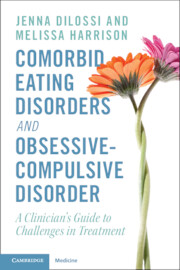 Comorbid Eating Disorders and Obsessive-Compulsive Disorder
Comorbid Eating Disorders and Obsessive-Compulsive Disorder Book contents
- Comorbid Eating Disorders and Obsessive-Compulsive Disorder
- Comorbid Eating Disorders and Obsessive-Compulsive Disorder
- Copyright page
- Contents
- Foreword
- Preface
- Acknowledgments
- Abbreviations
- Part I Overview of the Existing Literature
- Chapter 1 Understanding Eating Disorders
- Chapter 2 Review of Eating Disorder Treatment
- Chapter 3 Understanding Obsessive-Compulsive Disorder
- Chapter 4 Diagnostic Comorbidity and Phenomenological Overlap of Eating Disorders and Obsessive-Compulsive Disorder
- Chapter 5 Identifying Common Themes across Treatments for Eating Disorders and Obsessive-Compulsive Disorder
- Chapter 6 Identifying Mechanisms of Action across Treatments for Eating Disorders and Obsessive-Compulsive Disorder
- Part II Clinical Pitfalls and Treatment Failures
- Part III Evidence-Informed Considerations for Assessment and Treatment
- Part IV Special Topics and Future Considerations
- References
- Index
Chapter 4 - Diagnostic Comorbidity and Phenomenological Overlap of Eating Disorders and Obsessive-Compulsive Disorder
from Part I - Overview of the Existing Literature
Published online by Cambridge University Press: 14 December 2023
- Comorbid Eating Disorders and Obsessive-Compulsive Disorder
- Comorbid Eating Disorders and Obsessive-Compulsive Disorder
- Copyright page
- Contents
- Foreword
- Preface
- Acknowledgments
- Abbreviations
- Part I Overview of the Existing Literature
- Chapter 1 Understanding Eating Disorders
- Chapter 2 Review of Eating Disorder Treatment
- Chapter 3 Understanding Obsessive-Compulsive Disorder
- Chapter 4 Diagnostic Comorbidity and Phenomenological Overlap of Eating Disorders and Obsessive-Compulsive Disorder
- Chapter 5 Identifying Common Themes across Treatments for Eating Disorders and Obsessive-Compulsive Disorder
- Chapter 6 Identifying Mechanisms of Action across Treatments for Eating Disorders and Obsessive-Compulsive Disorder
- Part II Clinical Pitfalls and Treatment Failures
- Part III Evidence-Informed Considerations for Assessment and Treatment
- Part IV Special Topics and Future Considerations
- References
- Index
Summary
Studies have shown that eating disorders (EDs) and obsessive-compulsive disorder (OCD) have a high rate of comorbidity. Childhood anxiety disorders have been found to predict the onset of EDs. Researchers propose that OCD and EDs are part of the same spectrum of disorders, with AN being a specific type of OCD similar to body dysmorphic disorder. Malnutrition is a primary factor leading to complications in this presentation as it can compromise medical safety, worsen cognitive functioning, hinder insight and perception of reality, and increase obsessionality. Both groups experience symptoms such as intrusive cognitions, perfectionism, avoidance, and ritualistic behavior, which require specific interventions and complex clinical expertise for positive treatment outcomes. Maladaptive perfectionism is common in both disorders, leading to self-defeating behavior and daily impairment. Avoidance and ritualistic behavior are common in both disorders and are motivated by maladaptive cognitions related to catastrophic outcomes and beliefs about morality, achievement, and identity. These behaviors serve to alleviate anxiety associated with these cognitive domains.
- Type
- Chapter
- Information
- Comorbid Eating Disorders and Obsessive-Compulsive DisorderA Clinician's Guide to Challenges in Treatment, pp. 28 - 34Publisher: Cambridge University PressPrint publication year: 2023
